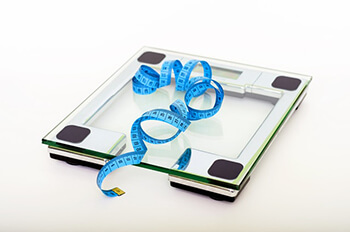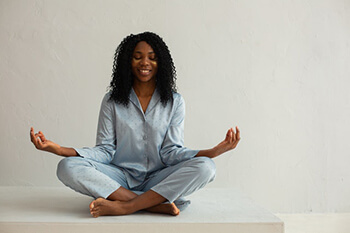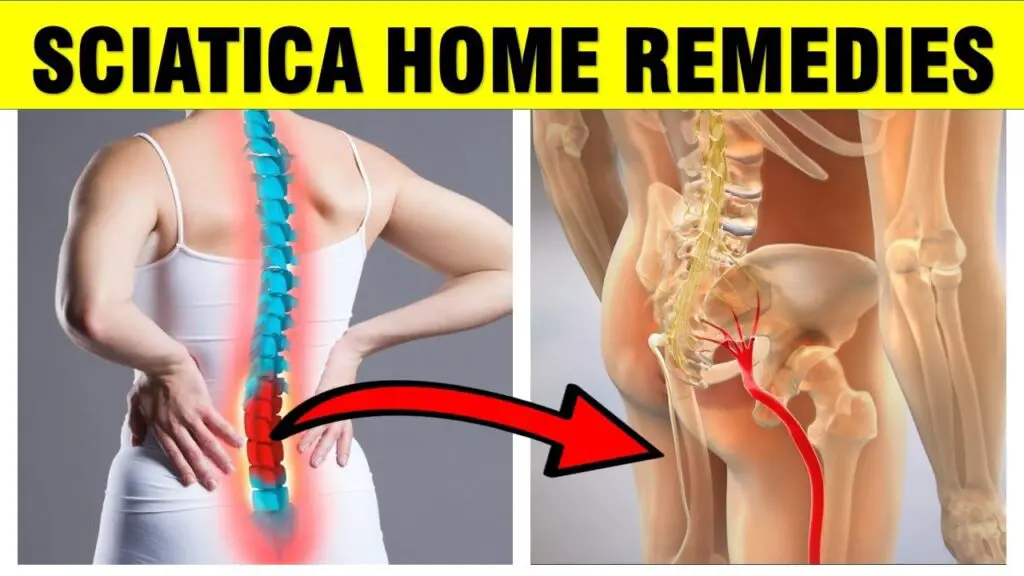Sciatica affects up to 40% of the world population. It's estimated that on a single day day no less than 10% of the population is experiencing this sciatic pain, and that number is potentially as high as 40%. This makes sciatic pain one of the most common types of discomfort experienced in the human body.
With so many of us experiencing sciatica pain, are there any easy home remedies we can try out to reduce back, hip, buttock and leg pain, and provide immediate relief? This guide will identify processes you can follow to reduce pain, including poses and stretches among other methods. These simple practices can provide significant pain relief and ease sciatica symptoms quickly.
What is the Sciatic Nerve?
The sciatic nerve is the largest nerve in your body. The sciatic nerve begins at your lower back, travelling from the base of your spine into your hips, buttocks and down each of your legs.
What Does the Sciatic Nerve Do?
The main function of the sciatic nerve is to allow for leg movement. Nerves feed into your leg muscles to enable motor function, as well as hip movement, knee bending, and movement of feet and toes.
The sciatic nerve also has a sensory purpose, enabling you to feel hot and cold, and touch and vibration on your legs.
What is Sciatic Nerve Pain?
Sciatic nerve pain, or sciatica, occurs when there is an issue within this nervous system. As the largest nerve in the body, it is the most common nerve to cause discomfort. Sciatica pain may present itself as leg pain, back pain, hip pain, or buttock pain.
What Causes Sciatic Pain?
There are many causes of sciatic nerve pain. The most common cause of sciatica pain is a ruptured spinal disc. A disc is the cushioning between the spinal bones in your spinal cord. If a spinal disc ruptures, it may come into contact with the nerve, resulting in severe pain.
Alternatively, you may have experienced a narrowing of the spinal canal. This can cause significant back pain, which may be a factor in identifying that you have sciatica.
What are the Symptoms of Sciatica?
If you're experiencing sciatica pain, it's likely that either your buttocks, hips, legs or feet are subject to pain. The pain of sciatica tends to present itself as a stabbing or shooting pain, causing significant discomfort.
You may be experiencing sciatica even if your symptoms are less intense. A simple pins and needles sensation may indicate that sciatica is occurring, as can numbness in these areas.
If you're only feeling pain or weakness in your back, this is more likely to be some other form of back pain and not sciatica.
What Triggers Sciatica?


Sciatica pain is greatly increased depending on factors such as height and weight. Being overweight is a major factor in causing sciatica or worsening sciatica pain. Having a sedentary lifestyle is advised against because regular exercise limits the chances of developing sciatica. Physical activity is one of the most effective remedies you can engage with to reduce pain in your legs, back and hip area.
If you sleep on a bad mattress, this can trigger sciatica and make discomfort in your back and legs worse. Pregnancy may worsen sciatica due to the added weight during this time, and hormonal changes. Post-pregnancy, most sciatica patients describe a decline in the pain they experience.
Wearing high heels forces you to lean forward at the hips. This change in your centre of gravity can put immense pressure on areas of your body where the sciatic nerves are. High-heeled shoes without cushioned insoles contribute to impact to your back. You may find wearing high heels for shorter durations will relieve you of some of the discomfort you're feeling.
A pair of tight-fitting jeans is also a risky item when it comes to sciatica. This is because tight or skinny jeans put pressure on the lower back, hips and legs. Sitting for long periods of time with items in your back pockets, such as wallets or phones, also increases risk.
Research suggests that stress, anxiety and depression are proven to worsen sciatica. Self care is crucial to your health in many ways, so you should find time to relax.

Exercising To Reduce Sciatica Pain
Exercising is the easiest way to reduce discomfort from sciatica. It's also the cheapest method available to you, because all the exercises listed from here don't require any special equipment. This means that you won't need to spend a cent on these at-home treatments.
Try these positions before considering booking physical therapy from a physical therapist. They might do the job in lessening your pain.
Knee-To-Chest Stretch
Knee-to-chest stretches are incredibly easy and don't require you to do anything too strenuous. Simply lie on your back facing the ceiling or sky, with both your left foot and right foot pointing upwards. Ensure your face is pointing upwards too.
Bend your left knee towards your chest and hold it in place with both hands. Hold it for as long as you feel comfortable up to 40 seconds before bringing it back down to the floor and straightening. Once you've done this with your left leg, move to your right leg - lifting your right knee to your chest, holding it there for up to 40 seconds, and releasing. Repeat this process three or four times for both your left and right leg. If sciatic pain persists, repeat this exercise once a day for more than a month to start to see results.
To ensure you're comfortable throughout this stretch, you should rest your head on a pillow or cushion and only hold your knee to your chest for as long as it is comfortable to do so. If it is causing significant pain on one leg, try to preference moving the other leg.
Plank


Performing a plank requires a little more energy but is nevertheless a position you can achieve.
Lie face down on a solid surface. Lift up onto your forearms and toes, keeping your elbows pushed into your sides by your ribs. Hold this position for as long as you are able, up to 1 minute. Do this a couple of times a day for best results. In more severe cases of sciatica pain, you should aim for a dozen planks a day.
Repeat this process for a few weeks to see whether this exercise is working for you in combatting sciatica.
Meditation Pose


The meditation pose is what it says on the tin. You should sit as if you're meditating. To complete this exercise, sit on the floor with your legs out in front of you. Your legs should be straight. Next, put your right ankle on top of your left knee and fold your left leg towards you. Lean forward and hold for 30 seconds.
Meditation pose is a gentle exercise and shouldn't cause you any additional discomfort.
Leg-On-Chair
This exercise requires something every home has - a chair. Simply place your right foot onto a chair and bend your body in the direction of your foot. Hold this pose for 30 seconds and repeat until pain eases. You should only be doing gentle stretching and nothing vigorous enough to cause additional discomfort.
Hot and Cold Therapy To Ease Sciatica Pain
Hot and cold therapy is a great home remedy for you to try in your attempt to ease pain caused by sciatica. Cold is effective in reducing swelling, while heat works to increase blood flow in affected areas. Both methods are beneficial because they relieve pressure.
You can buy ice packs and heat packs at health stores. Place the packs on areas where you're experiencing pain, alternating between hot and cold. To save money, your cold solution may be something as simple as a bag of ice cubes or a bag of frozen peas. Your heat solution could be a hot water bottle or a warm towel. Always wrap heat packs and cold products in a tea towel to avoid extreme temperatures on your skin because this can cause other health issues.
Medication To Ease Sciatica Pain


Painkillers are effective in reducing the pain caused by sciatica. Over-the-counter medication such as ibuprofen is an effective pain reliever. Painkillers inform the brain to ignore musculoskeletal pain, reducing sciatica.
It's important you only ever take the recommended amount of painkillers, as outlined on the box and in the instructions. Painkillers are only intended as a treatment for short-term pain, so don't use them for longer than you're instructed to on the box.
Vitamins To Ease Sciatica Pain
Vitamins are a vital tool in your battle to reduce acute pain caused by sciatica. They are just as valuable as painkillers. Vitamins B1, B6, C and E are especially helpful. These vitamins will reduce damage to nerves and rebuild mobility capabilities.Conclusion
Sciatica is one of the major issues affecting the human body. The fact that up to 40% of the population have a sciatica diagnosis demonstrates the importance of understanding the methods you can use to prevent sciatica pain.
Sciatica causes back, buttock, hip and leg pain, so home remedies should focus on these areas. Treating sciatica is achievable through a range of exercises that can be practiced as isolated movements or together for maximum effect. If exercising at home isn't effective for you, consider visiting a physical therapist, who will be able to support you working out these areas.
If exercise isn't your preferred method of pain relief, heat therapy is a great alternative. Applying heat to affected areas can increase blood flow, fixing damage quicker. Ice therapy is effective as reducing inflammation which will alleviate pain.
While exercise and hot and cold therapy are the best methods for long term relief from sciatica pain, other treatment options include vitamins and painkillers.

